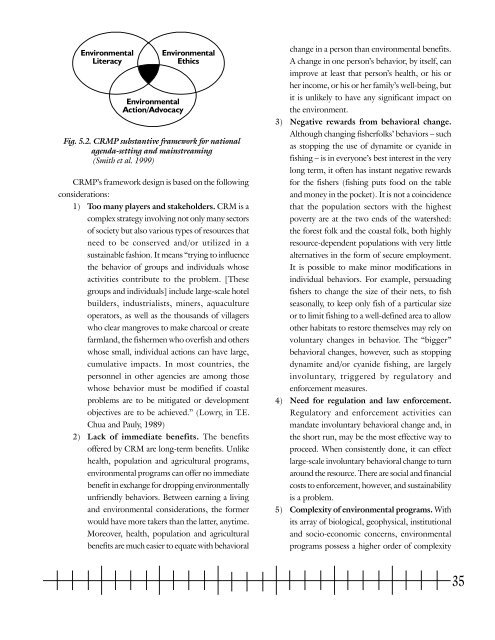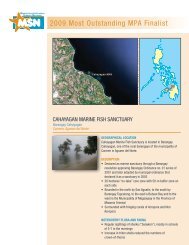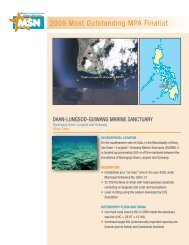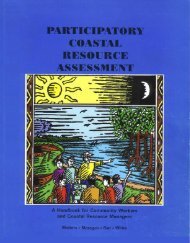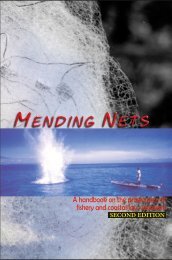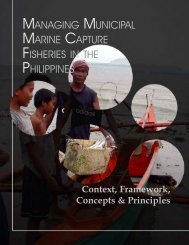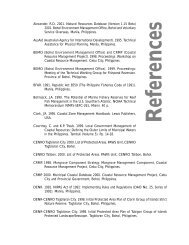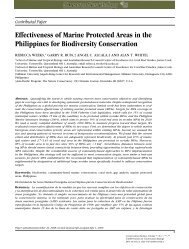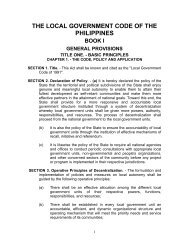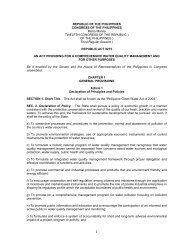Part 2 - Oneocean.org
Part 2 - Oneocean.org
Part 2 - Oneocean.org
- No tags were found...
You also want an ePaper? Increase the reach of your titles
YUMPU automatically turns print PDFs into web optimized ePapers that Google loves.
EnvironmentalLiteracyEnvironmentalAction/AdvocacyEnvironmentalEthicsFig. 5.2. CRMP substantive framework for nationalagenda-setting and mainstreaming(Smith et al. 1999)CRMP’s framework design is based on the followingconsiderations:1) Too many players and stakeholders. CRM is acomplex strategy involving not only many sectorsof society but also various types of resources thatneed to be conserved and/or utilized in asustainable fashion. It means “trying to influencethe behavior of groups and individuals whoseactivities contribute to the problem. [Thesegroups and individuals] include large-scale hotelbuilders, industrialists, miners, aquacultureoperators, as well as the thousands of villagerswho clear mangroves to make charcoal or createfarmland, the fishermen who overfish and otherswhose small, individual actions can have large,cumulative impacts. In most countries, thepersonnel in other agencies are among thosewhose behavior must be modified if coastalproblems are to be mitigated or developmentobjectives are to be achieved.” (Lowry, in T.E.Chua and Pauly, 1989)2) Lack of immediate benefits. The benefitsoffered by CRM are long-term benefits. Unlikehealth, population and agricultural programs,environmental programs can offer no immediatebenefit in exchange for dropping environmentallyunfriendly behaviors. Between earning a livingand environmental considerations, the formerwould have more takers than the latter, anytime.Moreover, health, population and agriculturalbenefits are much easier to equate with behavioralchange in a person than environmental benefits.A change in one person’s behavior, by itself, canimprove at least that person’s health, or his orher income, or his or her family’s well-being, butit is unlikely to have any significant impact onthe environment.3) Negative rewards from behavioral change.Although changing fisherfolks’ behaviors – suchas stopping the use of dynamite or cyanide infishing – is in everyone’s best interest in the verylong term, it often has instant negative rewardsfor the fishers (fishing puts food on the tableand money in the pocket). It is not a coincidencethat the population sectors with the highestpoverty are at the two ends of the watershed:the forest folk and the coastal folk, both highlyresource-dependent populations with very littlealternatives in the form of secure employment.It is possible to make minor modifications inindividual behaviors. For example, persuadingfishers to change the size of their nets, to fishseasonally, to keep only fish of a particular sizeor to limit fishing to a well-defined area to allowother habitats to restore themselves may rely onvoluntary changes in behavior. The “bigger”behavioral changes, however, such as stoppingdynamite and/or cyanide fishing, are largelyinvoluntary, triggered by regulatory andenforcement measures.4) Need for regulation and law enforcement.Regulatory and enforcement activities canmandate involuntary behavioral change and, inthe short run, may be the most effective way toproceed. When consistently done, it can effectlarge-scale involuntary behavioral change to turnaround the resource. There are social and financialcosts to enforcement, however, and sustainabilityis a problem.5) Complexity of environmental programs. Withits array of biological, geophysical, institutionaland socio-economic concerns, environmentalprograms possess a higher order of complexity35


